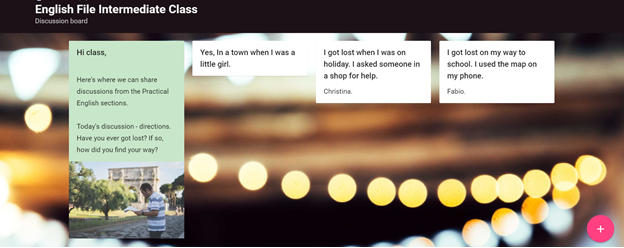Over the last year, as many teachers have moved either partly or fully to remote teaching, one question has arisen many times: How do I keep my students engaged online? Whilst many teachers have their go-to folder of ready-to-use adaptable activities, comprised of the likes of board races, role-plays, flashcard games, and many more steadfast materials, the idea of digitising these activities has seemed somewhat impossible. Teachers feel like they have lost their time-savers.
Whilst I can’t offer a solution on how to do a board-race activity through a Zoom lesson (that is impossible), what I can suggest are some alternative tools and platforms that teachers can add to their pre-existing arsenal of hit-the-ground-running classroom activities and exercises. So, in no particular order, here are my top 5 platforms for improving student engagement online.
1. Padlet
I rave about Padlet so much, my colleagues must think I secretly work for them! Padlet is one of the most easily accessible platforms out there for sharing content, ideas, and general brainstorming. I’ve used it synchronously for online workshops, and find it offers a nice change of scenery for engagement that’s not your usual ‘type into the chatbox’ responses. Padlet can also be used asynchronously, making it a great platform for assigning homework. As a teacher, you can add content to a Padlet ahead of a lesson, allowing your students access by simply sharing a link with them. Content can be in the form of text, images, and links to videos or other websites– think of it as a digital whiteboard, but one that everyone can work and collaborate from (and with more visually engaging backgrounds!)

2. Kahoot
I previously used Kahoot when I was teaching in the face to face classroom, but I’ve since learnt that it also works for remote learning, both synchronously and asynchronously. Kahoot not only offers fun gamification of learning, but it can also be used as a tool to assess learners and measure their progress – something many teachers have found challenging to do in a distance classroom set-up. You can use pre-made games or ‘Kahoots’ with your learners, or you can create your own Kahoots ahead of your lesson.
I strongly recommend taking the time to watch the video guide by Isabella Vick, Marketing and Community Assistant from Kahoot, on how to deliver lessons remotely using the platform.
3. Quizlet
The majority of my experience in using Quizlet comes from being a student myself. When I was studying for my Delta Module One exam, Quizlet was my best friend. For anyone else who’s done this exam, or any written exam for that matter, you’ll know that expanding your repertoire of vocabulary terms and phrases is a key focus in your exam preparation. Quizlet allowed me to test my vocabulary knowledge with digital flashcards using gamification, and, dare I say it, I actually enjoyed doing it. As with most gamification of learning, there was an inherent satisfaction that came from selecting the correct definition for the word that had been presented to me. And like Kahoot, there are pre-made quizzes that you can access, or you can simply create your own.
4. Future Me
With all the talk of hope on the horizon through the roll-out of vaccines, the gradual easing of lockdowns, and the slow return to face-to-face learning, I thought it would be fitting to mention a platform that also focuses on the future. Future Me is a website that allows you to write a letter to your future self. You compose your letter, add in your email address, and set the date of delivery for maybe a year, 5 years, or even 10 years – or, you can choose a specific date. Whilst this activity doesn’t offer much in the form of immediate content production, and the teacher feedback that comes with this, it can be a novel activity to do at the start of a semester or term.
Offer letter-writing support through the use of sentence stems, such as By the end of this academic year, I want to be able to… or by reflecting on their current ‘status’ as students, e.g. Right now I’m not very confident with… this year, I hope to improve on…. Then have your students set the delivery date for the last week of their academic year and when the time comes, get them to reflect on their letters, and if comfortable, share them with their peers. It can be a poignant way to end the term, but a memorable one.
5. Gimkit
This platform has two different sections: Gimkit Live, for quiz-like activities, and Gimkit Ink, for more project or assignment style tasks. Gimkit Live is a lot like Kahoot, except the students receive a reward in the form of ‘in-game cash’ every time they answer a question correctly. They can also lose credits if they get answers incorrect, so be sensitive to your learners’ motivational drivers when considering this platform. Whilst both Live and Ink offer the chance for collaboration between learners, what I really like about Ink is the opportunity for students to post their work anonymously, with only the teacher seeing that the work has come from them. This is a feature that really tells me Gimkit have listened to their teachers and the challenges they face trying to get engagement online from shy, self-conscious students.
So there you have it, my top 5 recommendations to make remote learning more fun and promoting engagement online. By far these are not the only platforms out there, but they’re worth checking out if you’ve not come across them before.
And if you do try them, or you’ve already used them, let me know what you think in the comments!
Charlotte Murphy has over 8 years of teaching experience working with Young Learners, Teenagers, and Adults across all levels, from beginner to proficiency. She currently works as a teacher trainer for OUP. Follow Charlotte on Twitter @Charlot89877696!



Very inspiring. Thank you
Thank you, Nshom Joseph Nkwain.
Thanks a lot for this great article!
A question… is it possible to apply to write guest posts on here? I would be very much interested. I have emailed [email protected] but no reply yet.
Thanks in advance 🙂
Hi there, thanks for getting in touch! I’ve looked into this for you and can confirm that we’ve received your email. We are open to guest bloggers at the moment; I’ve notified the relevant team of your email and they will be in touch in the near future to discuss this with you further. Hope this helps, ^Chesca
Great, thanks Chesca! 🙂
Hi,
A problem I have found with some of the external online platforms and games is that they are not accessible in China. Is there a way to check these before planning a lesson using Kahoot for example?
Thanks
Hi Alex,
A very good question! It’s always good to check the international access for the platforms you choose to use, if you have remote learners who are working out of a different country to the one that you’re based in. Regarding access in China, chat forums for teachers are your best approach for checking availability – aside from asking your students. I stumbled across a Reddit group, Teachers of r/China, that seems to address questions such as yours.
Regards,
Charlotte.
Padlet is definitely my go to collaborative tool. I use it almost in every lesson. One of the topics I teach my students in one of the polytechnics in Malaysia is ‘Describing Products and Services’. I have them designed a poster (Canva.com) that mainly highlights the features, characteristics and functions of their products. The students then share their posters in a designated Padlet wall which can be viewed by the other teams in the class. Here is my favourite feature of Padlet, it allows students to comment, like, vote, give star ratings or a grade on the posts. By enabling these features, my students are given the opportunities for peer feedbacks. The work shared are celebrated when peers leave positive feedback. 🙂
The Very Respect The University of Oxford Dear Respect Sir/ Madam, I am Md. Asif Alamgir. I am the respect your registered regular student. I am the respect certified course teacher. At First We very need is essential education and become a certified respect teacher. We need important money for to make the study classroom. As a respect teacher we need to do earn money by conduct education business. Sincerely, Md. Asif Alamgir.
[…] 5 Fun Ways To Increase Student Engagement Online — Oxford University Press […]